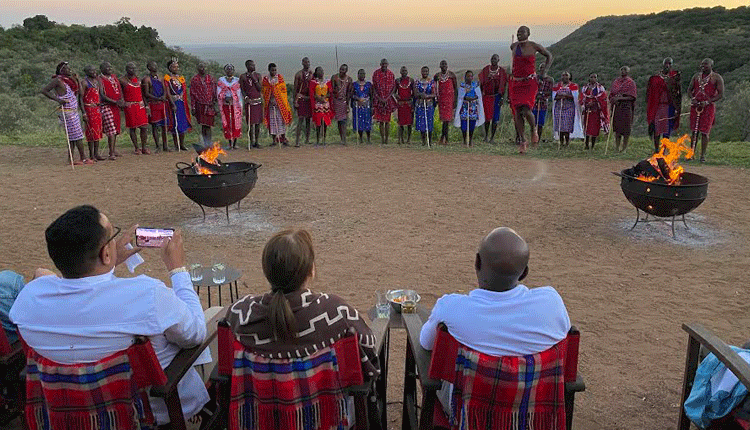Players hopeful about Masai Mara tourism comeback
By Harriet James, September 2, 2021“There is plenty of food in Masai Mara, that is why the elephant families are still walk in large numbers,” says Tito Karega, my tour guide from Angama Mara camp pointing at a herd of elephants grazing from a distance.
“But during drought seasons, they split to find pasture in different places,” he adds
Like in many other game drives, I was learning interesting facts that my guide was sending my way particularly when we met an animal.
I also learnt that most elephants hide in the escarpment or thickets during the wildebeest migration season, as they hate the noise from the gnus. They love their peace and quiet.
While I enjoyed the game drive, my heart and attention was keen on watching the ongoing wildebeest crossing, and listening to exciting stories of those who have already watched the most phenomenal natural spectacle in the world.
So during the game drive, my eyes were constantly roving, latching onto any sign or movement that might morph into the wildebeests crossing.
While at it, I notice quite a number of tourists at the reserve, to which my guide confirms that there has been a slight improvement from last year when the Covid-19 pandemic was at its peak.
Many camps were closed during the migration, others shut down completely and camp employees lost their jobs.
The camps are crediting the increased visitor arrivals to ongoing vaccinations, which have boosted the confidence of international guests, particularly from the United States and Russia to visit the country.
However, hospitality players are calling for prioritisation of hotel workers in the vaccination exercise terming them as frontline workers since they are exposed to different Covid-19 variants from across the world on a daily basis.
“Those of us who are far away from major urban centres where vaccinations are offered are disadvantaged because of poor roads, which makes it costly to transport our staff to get vaccinated.
I would recommend that the drive should be targeted, especially in hard-to-reach areas, such as Masai Mara,” says Azei Lago, the General Manager, Angama Mara.
The players are upbeat about plans by the Kenya Airports Authority (KAA) to commence the rehabilitation of Angama (Olkurruk) Airstrip located in the western part of the game reserve, saying it will open up the Mara Tourism Circuit.
“Kenya prides itself as the regional centre of excellence in terms of tourism and this is the perfect launch site for the region.
With the international airport, we can have guests in the Mara fly in directly, which will save both time and money,” says Azei.
Currently, guests desiring to tour Serengeti National Park in Tanzania from the Mara will have to take a one and a half-hour flight to Nairobi and then take another one and a half flight to Kilimanjaro before taking another flight to Serengeti, which means it’s a whole day of travel for the guests.
If there was a border post at the Mara, it would take approximately two hours to get to Tanzania making the expansion of this airline great news for the travellers.
Attract more tourists
“It will encourage luxury travellers, who own private jets to tour the destination, especially when they know that they can land in the Mara directly.
That back and forth of having to land in Nairobi first for clearance before heading to the Mara is cumbersome, because one has to embark on another journey to the reserve on road. An airport it will attract more tourists to the destination,” notes Azei.
Updating on the migration, hoteliers in the Mara have noted new developments when it comes to the gnus crossings for the past three years.
Jackson Looseiya, Safari host and co-founder of Tangulia camp compares how the migration used to take place i the past and currently.
“Presently, the crossings are not taking place in many places, but at the border.
For the last three years the wildebeests just stay at the borderline and then leave to head back to the Serengeti.
The main crossing where some of the wildebeests are preyed on is not as active anymore.
Nobody can explain it, maybe it’s due to human pressure, but animals are clever and it’s about generations.
If they watched their mother passing there and was captured, they will never pass through the same spot because it’s dangerous,” he explains.
Looseiya adds that in the past, the Masai Mara National Reserve was so large stretching up to the Loita plains and beyond.
Wildlife would go all the way back to Rift Valley. Then slowly by slowly with the increase of the human population, the land began to shrink and wildlife was pushed away.
Migratory corridors, particularly at the Loita area where migration would take place shrank as well.
“The moment the demarcation of land happened at Loita planes five to six years ago, people began fencing and animals were pushed away.
Forests, that offered home, cover and food for the animals have also been cut down for use in construction and fencing.
People are also building near the rivers too and this also scared the animals making them disappear,” he further adds.
He urges the Ministry of Tourism and Wildlife to check on the wildlife corridors and ensure that people don’t build along them.
“Animals know their historical migration routes. When the migration is taking place, you’ll find lions and cheetahs in specific locations because they know.
Loita migration has shifted into conservancies so right now the government should work with the conservancies and safeguard the wildlife corridors,” he explains.
